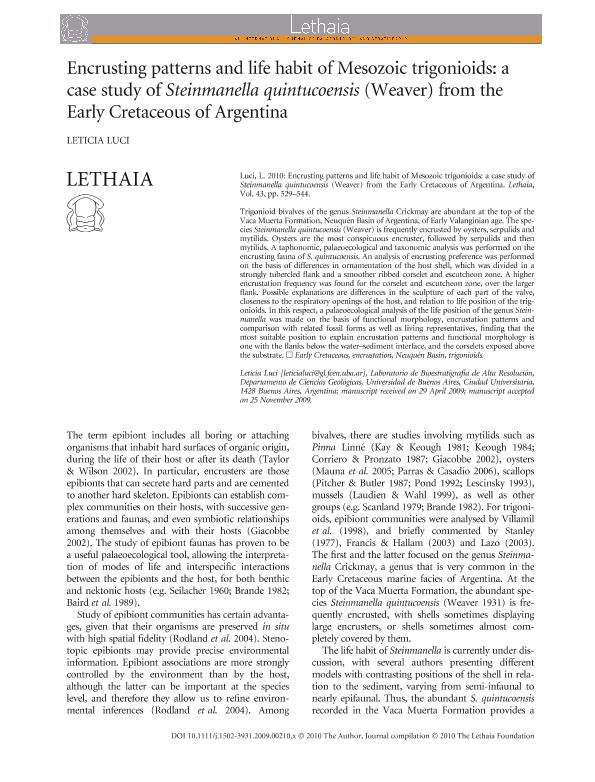Artículo
Encrusting patterns and life habit of Mesozoic trigonioids: A case study of Steinmanella quintucoensis (Weaver) from the Early Cretaceous of Argentina
Fecha de publicación:
12/2010
Editorial:
Wiley Blackwell Publishing, Inc
Revista:
Lethaia
ISSN:
0024-1164
Idioma:
Inglés
Tipo de recurso:
Artículo publicado
Clasificación temática:
Resumen
Trigonioid bivalves of the genus Steinmanella Crickmay are abundant at the top of the Vaca Muerta Formation, Neuquén Basin of Argentina, of Early Valanginian age. The species Steinmanella quintucoensis (Weaver) is frequently encrusted by oysters, serpulids and mytilids. Oysters are the most conspicuous encruster, followed by serpulids and then mytilids. A taphonomic, palaeoecological and taxonomic analysis was performed on the encrusting fauna of S. quintucoensis. An analysis of encrusting preference was performed on the basis of differences in ornamentation of the host shell, which was divided in a strongly tubercled flank and a smoother ribbed corselet and escutcheon zone. A higher encrustation frequency was found for the corselet and escutcheon zone, over the larger flank. Possible explanations are differences in the sculpture of each part of the valve, closeness to the respiratory openings of the host, and relation to life position of the trigonioids. In this respect, a palaeoecological analysis of the life position of the genus Steinmanella was made on the basis of functional morphology, encrustation patterns and comparison with related fossil forms as well as living representatives, finding that the most suitable position to explain encrustation patterns and functional morphology is one with the flanks below the water-sediment interface, and the corselets exposed above the substrate. Early Cretaceous, encrustation, Neuquén Basin, trigonioids.
Palabras clave:
Early Cretaceous
,
Encrustation
,
Neuquén Basin
,
Trigonioids
Archivos asociados
Licencia
Identificadores
Colecciones
Articulos(IDEAN)
Articulos de INSTITUTO DE ESTUDIOS ANDINOS "DON PABLO GROEBER"
Articulos de INSTITUTO DE ESTUDIOS ANDINOS "DON PABLO GROEBER"
Citación
Luci, Leticia; Encrusting patterns and life habit of Mesozoic trigonioids: A case study of Steinmanella quintucoensis (Weaver) from the Early Cretaceous of Argentina; Wiley Blackwell Publishing, Inc; Lethaia; 43; 4; 12-2010; 529-544
Compartir
Altmétricas




